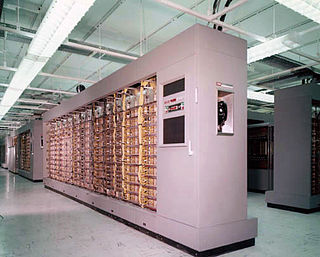
The Semi-Automatic Ground Environment (SAGE) was a system of large computers and associated networking equipment that coordinated data from many radar sites and processed it to produce a single unified image of the airspace over a wide area. SAGE directed and controlled the NORAD response to a possible Soviet air attack, operating in this role from the late 1950s into the 1980s. Its enormous computers and huge displays remain a part of Cold War lore, and after decommissioning were common props in movies such as Dr. Strangelove and Colossus, and on science fiction TV series such as The Time Tunnel.

Strategic Air Command (SAC) was a United States Department of Defense Specified Command and a United States Air Force (USAF) Major Command responsible for command and control of the strategic bomber and intercontinental ballistic missile components of the United States military's strategic nuclear forces from 1946 to 1992. SAC was also responsible for strategic reconnaissance aircraft; airborne command posts; and most of the USAF's aerial refueling aircraft.

Offutt Air Force Base is a U.S. Air Force base south of Omaha, adjacent to Bellevue in Sarpy County, Nebraska. It is the headquarters of the U.S. Strategic Command (USSTRATCOM), the 557th Weather Wing, and the 55th Wing of the Air Combat Command (ACC), the latter serving as the host unit.

TACAMO is a United States military system of survivable communications links designed to be used in nuclear warfare to maintain communications between the decision-makers and the triad of strategic nuclear weapon delivery systems. Its primary mission is serving as a signals relay, where it receives orders from a command plane such as Operation Looking Glass, and verifies and retransmits their Emergency Action Messages (EAMs) to US strategic forces. As it is a dedicated communications post, it features the ability to communicate on virtually every radio frequency band from very low frequency (VLF) up through super high frequency (SHF) using a variety of modulations, encryptions and networks, minimizing the likelihood an emergency message will be jammed by an enemy. This airborne communications capability largely replaced the land-based extremely low frequency (ELF) broadcast sites which became vulnerable to nuclear strike.

The RCA 474L Ballistic Missile Early Warning System was a United States Air Force Cold War early warning radar, computer, and communications system, for ballistic missile detection. The network of twelve radars, which was constructed beginning in 1958 and became operational in 1961, was built to detect a mass ballistic missile attack launched on northern approaches [for] 15 to 25 minutes' warning time also provided Project Space Track satellite data.

The AN/FSQ-7 Combat Direction Central, referred to as the Q7 for short, was a computerized air defence command and control system. It was used by the United States Air Force for ground-controlled interception as part of the Semi-Automatic Ground Environment network during the Cold War.
The IBM AN/FSQ-31 SAC Data Processing System was a USAF command, control, and coordination system for the Cold War Strategic Air Command (SAC). IBM's Federal Systems Division was the prime contractor for the AN/FSQ-31s, which were part of the TBD 465L SAC Automated Command and Control System (SACCS), a "Big L" system of systems which had numerous sites throughout the Continental United States: "all SAC command posts and missile Launch Control Centers", a communication network, etc.; and the several FSQ-31 sites including:

A launch control center (LCC), in the United States, is the main control facility for intercontinental ballistic missiles (ICBMs). A launch control center monitors and controls missile launch facilities. From a launch control center, the missile combat crew can monitor the complex, launch the missile, or relax in the living quarters. The LCC is designed to provide maximum protection for the missile combat crew and equipment vital to missile launch. Missile silos are common across the midwestern United States, and over 450 missiles remain in US Air Force (USAF) service.

The Boeing EC-135 is a retired family of command and control aircraft derived from the Boeing C-135 Stratolifter. During the Cold War, the EC-135 was best known for being modified to perform the Looking Glass mission where one EC-135 was always airborne 24 hours a day to serve as flying command post for the Strategic Air Command in the event of nuclear war. Various other EC-135 aircraft sat on airborne and ground alert throughout the Cold War, with the last EC-135C being retired in 1998. The EC-135N variant served as the tracking aircraft for the Apollo program.

Looking Glass is the historic code name for an airborne command and control center operated by the United States. In more recent years it has been more officially referred to as the ABNCP. It provides command and control of U.S. nuclear forces in the event that ground-based command centers have been destroyed or otherwise rendered inoperable. In such an event, the general officer aboard the Looking Glass serves as the Airborne Emergency Action Officer (AEAO) and by law assumes the authority of the National Command Authority and could command execution of nuclear attacks. The AEAO is supported by a battle staff of approximately 20 people, with another dozen responsible for the operation of the aircraft systems. The name Looking Glass, which is another name for a mirror, was chosen for the Airborne Command Post because the mission operates in parallel with the underground command post at Offutt Air Force Base.

The 625th Strategic Operations Squadron (STOS) is a United States Air Force nuclear missile control & support squadron. The 625th STOS has five flights that play different roles in this mission. The Latin motto of the 625th STOS is Si vis pacem para bellum, which means, "If you wish for peace, prepare for war."
The AN/FRC-117 Survivable Low Frequency Communications System (SLFCS) was a communications system designed to be able to operate, albeit at low data transfer rates, during and after a nuclear attack. The system used both very low frequency (VLF), and low frequency (LF) radio bands.

The Air Force Global Strike Command (AFGSC) is a Major Command (MAJCOM) of the United States Air Force, headquartered at Barksdale Air Force Base, Louisiana. AFGSC provides combat-ready forces to conduct strategic nuclear deterrence and global strike operations in support of combatant commanders. Air Force Global Strike Command is the Air Force's service component to the United States Strategic Command (USSTRATCOM).

The Emergency Rocket Communications System (ERCS) was designed to provide a reliable and survivable emergency communications method for the United States National Command Authority, using a UHF repeater placed atop a Blue Scout rocket or Minuteman II intercontinental ballistic missile. ERCS was deactivated as a communication means when President George H.W. Bush issued a message to stand down SIOP-committed bombers and Minuteman IIs on 27 September 1991. Headquarters SAC was given approval by the Joint Chiefs of Staff to deactivate the 494L payloads beginning 1 October 1992. However, Headquarters SAC believed it was inefficient and unnecessary to support ERCS past fiscal year 1991, and kept the accelerated deactivation schedule.

The Airborne Launch Control System (ALCS) provides a survivable launch capability for the United States Air Force's LGM-30G Minuteman III intercontinental ballistic missile (ICBM) force. The ALCS is operated by airborne missileers from Air Force Global Strike Command's (AFGSC) 625th Strategic Operations Squadron (STOS) and United States Strategic Command (USSTRATCOM). The system is located on board the United States Navy's E-6B Mercury, which serves as USSTRATCOM's "Looking Glass" Airborne Command Post (ABNCP). The ALCS crew is integrated into the ABNCP battle staff and is on alert around the clock.

Airborne Launch Control Centers provide a survivable launch capability for the United States Air Force's LGM-30 Minuteman Intercontinental Ballistic Missile (ICBM) force by utilizing the Airborne Launch Control System (ALCS) on board which is operated by an airborne missileer crew. Historically, from 1967–1998, the ALCC mission was performed by United States Air Force Boeing EC-135 command post aircraft. This included EC-135A, EC-135C, EC-135G, and EC-135L aircraft.
The Strategic Air Command DIgital Network (SACDIN) was a United States military computer network that provided computerized record communications, replacing the Data Transmission Subsystem and part of the Data Display Subsystem of the SAC Automated Command and Control System. SACDIN enabled a rapid flow of communications from headquarters SAC to its fielded forces, such as B-52 bases and ICBM Launch Control Centers.

The United States military's Air Force Satellite Communications (AFSATCOM) is a network of ground and space systems to allow rapid dissemination of communications to a worldwide audience. AFSATCOM's creation was during the height of the Cold War to guarantee that Emergency Action Messages would be received by Strategic Air Command nuclear forces.

The ITT 465L Strategic Air Command Control System was a Cold War "Big L" network of computer and communication systems for command and control of Strategic Air Command "combat aircraft, refueling tankers, [and] ballistic missiles". International Telephone and Telegraph was the prime contractor for Project 465, and SACCS had "Cross Tell Links" between command posts at Offutt AFB, March AFB, & Barksdale AFB (SACCS also communicated with the Cheyenne Mountain Complex and Air Force command posts. The 465L System included IBM AN/FSQ-31 SAC Data Processing Systems, Remote and Simplex Remote Communication Systems, SAC Network Control Office, "4-wire, Schedule 4, Type 4B alternate voice-data operation", and one-way communication with "ICBM launch control centers" In addition to IBM for the "Super SAGE type computers", another of the 6 direct subcontractors was AT&T,

The Missile Warning Center (MWC) is a center that provides missile warning and defense for United States Space Command's Combined Force Space Component Command, incorporating both space-based and terrestrial sensors. The MWC is located at Cheyenne Mountain Space Force Station.
















